What level of clinical knowledge can EDS provide to healthcare professionals and, starting from this, what value-added services can be created.
In the two previous articles (first and second) we examined the salient aspects of the Health Data Ecosystem and reasoned about which services it would be possible, in theory, to create on the data that will be present in the documents that will feed the Electronic Health Record.
The key question is what level of clinical knowledge can EDS provide to healthcare professionals and, from this, what value-added services can be implemented. To answer this question we need to understand what data is provided in the specifications of the HL7 CDA documents. The following figure summarizes the current situation (some documents have not yet been fully formalized).
Note: green check ins indicate mandatory data, orange checks are optional.
A doctor or nurse, when they are in front of a patient, would like to have a synoptic overview that includes the most relevant information: which pathologies he or she is suffering from; what medications you take; your laboratory results; vital signs; his hospitalizations and visits to the emergency room; which tests and visits he underwent; his allergies. In short, nothing very different from what is provided for in the Synthetic Health Profile (PSS) that family doctors should fill out.
But why did I use the conditional? Because although the compilation of the PSS has been required by national collective agreements for family medicine and by regional supplementary agreements for about ten years, general practitioners do not complete it for two main reasons: liability in the event that the PSS is not accurate or complete; the work necessary for its drafting because, in many cases, their medical records, although providing the required information, are not filled in correctly. It should also be noted that many sections of the PSS are actually optional.
Returning to useful information for the doctor, let’s consider diagnoses/health problems. There are only four documents that provide them: the emergency room report; the hospital discharge letter and the PSS, in which they are mandatory and the outpatient specialist report in which they are however optional.
In the absence of the PSS, a patient who does not have access to the ED or hospital admissions, or where these only report the diagnoses that determined the episodes of treatment, may not have any code (ICD9-CM) except, possibly, a specialist report outpatient where a well-intentioned doctor has noted this information.
And what about vital signs? They are provided, optional, only in the PS report or in the PSS. It is not much better for the history, nor for the physical examination. However, laboratory results, drugs (thanks to the TS system) and reports are good, for which however the diagnostic question is optional. As you can deduce by examining the table, the overall picture is not very comforting.
To make matters worse, some information may not actually be structured but reported only in narrative form, i.e. in free text.
Without an effective, complete and immediate representation of clinical data, the EDS could follow the fate of the ESF 1.0 which is little used in clinical practice, especially in the case of chronic or elderly patients, who have such a mass of documents that, without advanced visualization tools, takes too long to consult.
The feeling is that, so far, little attention has been paid to this issue which is indeed crucial. The specifications of the documents were defined, one at a time, without an overall clinical vision. We are investing around a billion euros, without considering the investments at the level of the application systems, without an in-depth analysis of the implications of the choices that have been made, without a simulation or feasibility tests on the clinical effectiveness of what has been designed.
3 – Continue
I like:
I like Loading…
